
8 minute read
Colombia Cruise: Remote Patagonia
Voyage to the end OF THE WORLD
Sailing through one of the most remote regions on earth means a cruise line has a big responsibility to care for the shores its passengers alight on, discovers Jeannine Williamson in Patagonia
Advertisement
Holding firmly onto the
ship’s handrail I extend a tentative rubber booted foot towards the rigid inflatable boat gently bobbing on the water below. Heeding the advice of the previous evening’s introductory talk I’m dressed “like an onion”, and in so many layers I bear more than a passing resemblance to the Michelin tyre man.
I’m certainly not kitted out to do any dainty dance steps but that’s the advice being issued by expedition leader Cristobal Villanueva. “Remember to do the cha cha cha as you get on the RIB,” he says. “Step on the step, step on the boat and then step inside.” Three easy moves later and I’m sitting next to a small group of fellow passengers and we head out across Admiralty Sound, an offshoot of the Strait of Magellan.
It was just over 500 years ago that Portuguese explorer Ferdinand Magellan discovered this strait while leading the first expedition to successfully circumnavigate the globe. It’s a natural passageway between the Atlantic and Pacific Ocean but at one time the corridor of icy cliffs stretching across Patagonia was seemingly impenetrable and impossible to navigate. Today it still remains one of the most isolated spots on earth and Australis is the only expedition cruise company to navigate the narrow fjords and shallow bays in the wake of Magellan and his pioneering men.
Delicate habitats
Alighting from the RIB at Ainsworth Bay is much easier. Crew members have put down a gangplank and I step out onto springy, wet grass. We set off on a nature hike and I begin to shed the onion-skin as I warm up, making a mental note not to wear so much the next day. We follow our guide into a sub-polar forest, stopping along the way as he spots calafate bushes huddling under trees and shrubs. The purple berries guarded by sharp thorns punctuate the verdant surroundings like small jewels and we stoop to taste them. They’re like blueberries - only better.
Deep in the woodland we pause at a crystal-clear waterfall tumbling down an emerald moss-covered rock face. Nearby is a small tree with
ur perfect cruise here yo Find
MAGELLANIC PENGUINS
VENTUS AUSTRALIS
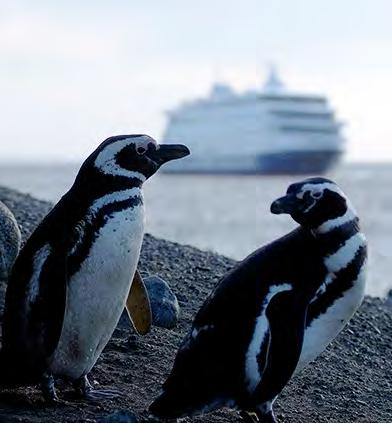
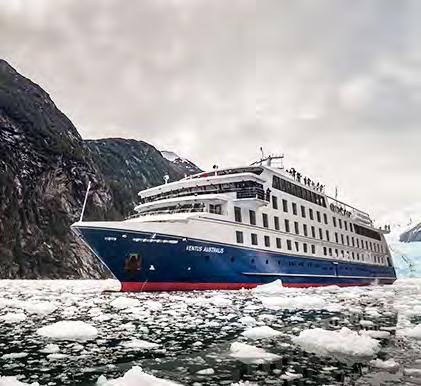
WULAIA BAY
an incongruous yellow tag and I wonder how on earth it got there. All becomes clear when we’re told that in 2013 a Chilean scientific organisation (CEQO) launched a unique and subsequently awardwinning conservation initiative in partnership with Australis to monitor the marine environment. Our guide says we’ll hear more about it in the ensuing days.
For now it’s time to head back to the 200-passenger Ventus Australis for lunch which, with sister ship Stella Australis, sails four and eightnight itineraries from September to April - from Punta Arenas in Chile to Ushuaia in Argentina, or the reverse - around the Patagonian fjords and islands of the Tierra del Fuego archipelago. These isles span almost 29,000 square miles with around two thirds governed by Chile and the rest by Argentina. Along with the Strait of Magellan, the network of connecting bodies of water include other evocative and fabled names such as the Beagle Channel and Drake Passage.
I’ve been assigned a dining table with fellow Brits and a Canadian couple and wine and other drinks are all included in the fare so it’s no surprise that the on board atmosphere is very convivial as we get to know each other.
Parading with penguins
That afternoon we cha cha cha back onto the RIBs and sail west along the sound to the cluster of small islands that make up Tucker Islets. More than 4,000 Magellanic penguins nest, hatch and nurture their chicks here and our helmsman steers the RIB close to the shore.
I delight at the spectacle of the large colony languishing on the shoreline, oblivious to our presence, and the unusual sight of penguins waddling off into long grass. The adults stand out, with their distinctive monochrome uniform of a thick black ‘necklace’ and a pair of black bands running across their creamy bellies. One is even more noticeable as it is completely white, a rare genetic quirk. Larger chicks stand longingly at the water’s edge, getting ready to moult their ugly duckling plumage in order to take the plunge for the first time. Until that happens they remain beach
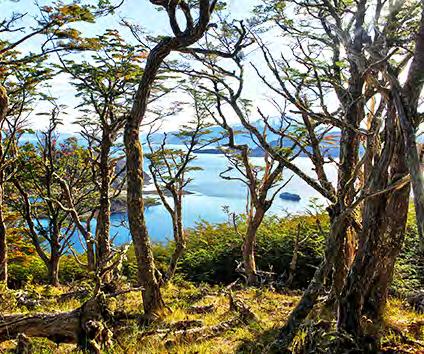
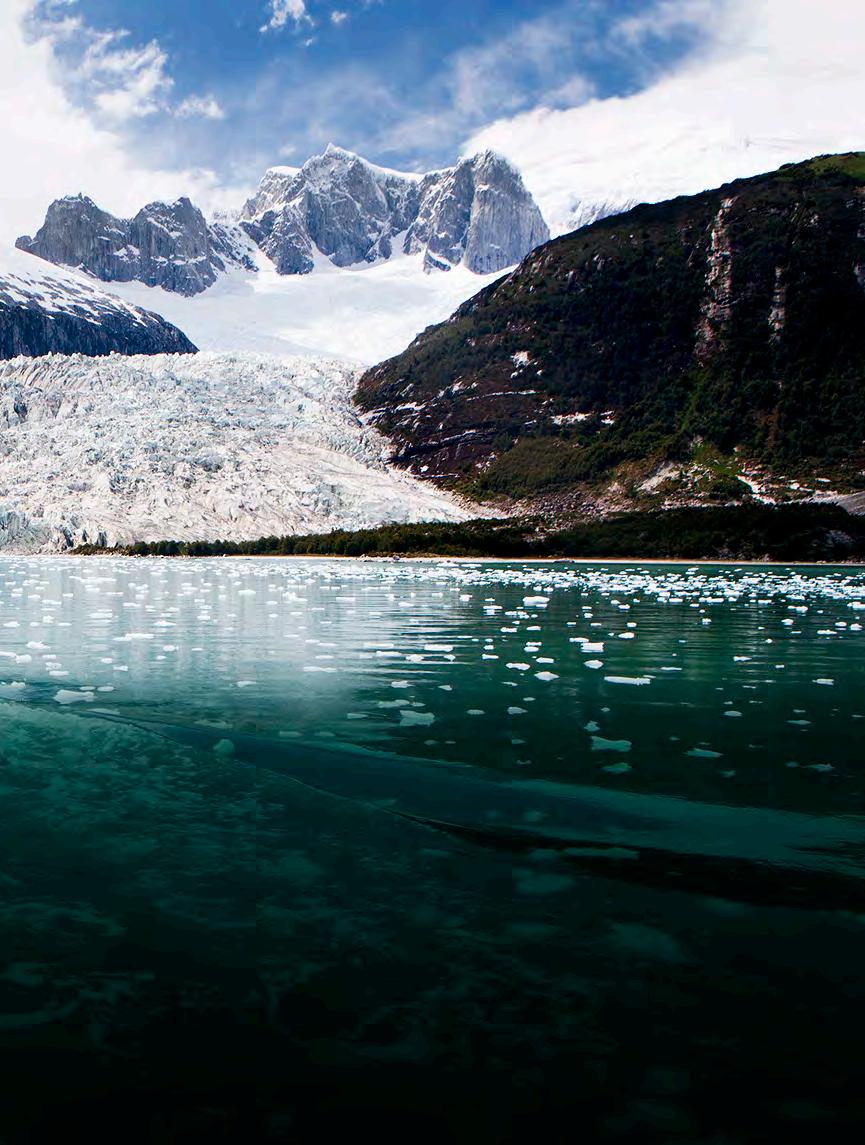
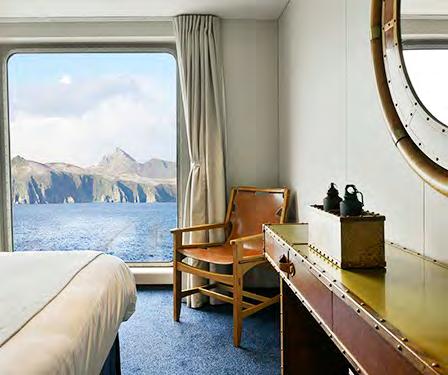
bound and awkwardly fluffy. and the cinnamon flash of Chilean
We watch, spellbound, for an skuas soaring overhead. Most hour before the RIB darts between breath-taking of all is the hunched some of the other islets. Patagonia outline of an Andean condor. The is a paradise for birdwatchers and largest bird in Patagonia, it cuts a we get close-up views of ground- figure that’s both menacing and nesting imperial majestic as it stands on a crag, cormorants scanning the rocky nursery for guarding their any eggs left unattended. eggs from predators on How to book Australis’ cruises between Eventually it gives up and, with a few slow-motion bare rocks Ushuaia and Punta Arenas can flaps of a 10-foot be combined with another cruise, wingspan, its huge including the Falkland Islands, a bulk takes off to seek new trip to Argentinian wine country feeding grounds. or any other iconic Latin American experience. Just ask Charitable Travel’s To top it off, enroute back to the ship dolphins follow experts the RIBs, diving playfully in the wash. There’s certainly plenty to talk about at dinner!
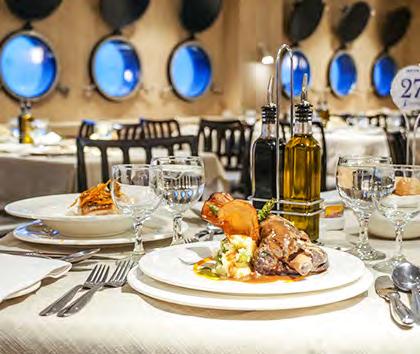
CABIN WITH A VIEW
Ice time
Next morning we arrive in Pia Fjord and after lunch disembark to visit the glacier of the same name, which is the largest and most active in Patagonia. Set against snowy mountains gleaming icy blue in the cloudless sky it’s incredible to see. Even more so when a loud creaking, followed by a thunderous crack, breaks our awe-struck silence. This is called calving and a piece of ice nearly 100ft high breaks away from the glacier and pierces the motionless water below, triggering waves carrying shards of shattered ice that make the RIBs pitch and roll in the maelstrom.
Nearly 90% of Chile’s glaciers are
Charitable Travel.pdf 1 29/01/2021 13:59 DINNER IS SERVED ONBOARD
Help our NHS heroes be the best they can be.
Every day, our doctors, nurses and healthcare workers go above and beyond - but they’re under constant pressure.
Leeds Hospitals Charity helps to provide extra equipment, facilities, research, education and support to our hospitals. With your help, we can fund things that make all the di erence.
To get involved, please visit www.charitable.travel/leeds-hospital

WALKING AT CAPE HORN
Set sail
Here are some other remarkable remote destinations which can be explored via an expedition cruise…
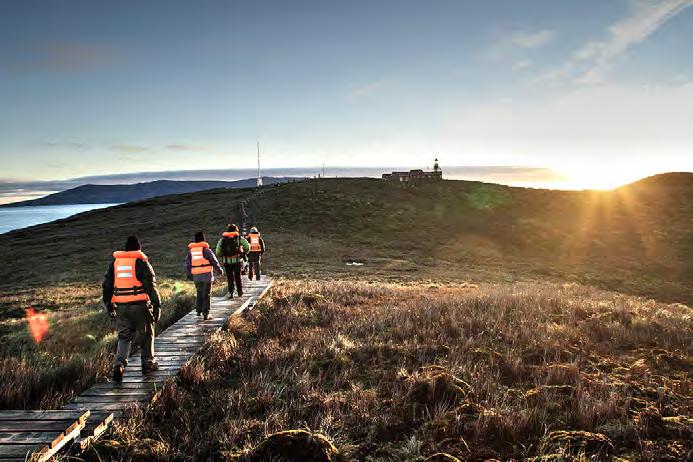
The Arctic Spitsbergen, the only permanently populated island in Norway’s Svalbard archipelago is one of the world’s northernmost inhabited areas. During the summer it is the gateway to Arctic sailings to spot polar bears and dramatic scenery.
The Galapagos This volcanic archipelago off the Ecuadorian coast is the ultimate trip for wildlife lovers,with 27 species unique to the islands. Visited by naturalist Charles Darwin this is the place where he developed his groundbreaking theory of evolution.
Antarctica South America’s southernmost tip leads to the most isolated continent on the globe. The frozen landscape is explored on daily Zodiac excursions or kayak expeditions. Combine a cruise with a stay in the buzzing Argentinian capital of Buenos Aires.
The Amazon South America’s largest river flows for 4,345 miles and more than 60% of Peruvian territory is covered by the Amazon rainforest. River cruises go from Iquitos, a two-hour flight from Lima, or on Brazilian seas cruises sailing to Manaus, 1,000 miles inland.

PIA GLACIER here and the following day we listen to another insightful lecture before sailing deeper into ‘glacier alley’.
“Glaciers are like people, they may look the same but they are all very different,” says Cristobal, as he explains how our guides act as the eyes and ears of scientists and collect data for studies and reports.
There’s a fixed camera at Pia
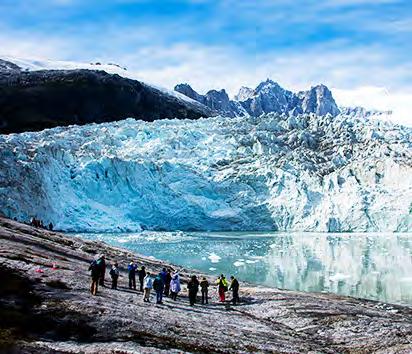
Glacier which takes a photo four times a day at the same time and sends it to the scientific programme, which is monitoring the advancing or retreating of the glacier, we’re told.
“Scientists don’t have the chance to come here very often as it is very expensive to do so,” says Cristobal. “But we are here all the time during the season so we record data. It also gives our guests the most accurate and up to date information.”
It turns out that the crew on the first Zodiac of the day, which takes the gangplank to the places we land, also carries out surveys in a set area of land at each place as well as taking water samples. They record flora and fauna.
“There’s a seagull colony where we count the number of adults, juveniles and chicks - it requires binoculars and patience,” says Cristobal, laughing.
Overnight we sail towards Nassau Bay, reaching the legendary Cape Horn at dawn. The excitement is palpable at breakfast as the ship
can only land passengers on the notoriously windswept island if weather and sea conditions permit. We’re lucky and scale the steps leading to the 1,394-foot high promontory overlooking the tempestuous waters of the Drake Passage. At one time it was the only navigation route between the Pacific and Atlantic, and referred to as the ‘End of the Earth.
That night I sip a fanshop, a refreshing Chilean tipple of beer and orange soda, and swap tales with fellow shipmates. We’ve bonded over an extraordinary voyage that lives, breathes and – via the scientific programme – protects the wild, untamed beauty of Patagonia.










